 W
WThe coat of arms of the Autonomous Republic of Adjara is a shield divided in two by a wavy line. In the center is a red smaller shield of the Lesser Arms of Georgia, bearing a silver horseman with a golden halo mounted on a silver horse and slaying a silver dragon with a golden-tipped, silver-shafted spear. The upper sector of the main shield bears a golden fortress on a green field and the lower one contains three golden coins on blue field.
 W
WThe coat of arms of Bucharest is the heraldic symbol of the capital city of Romania. The present-day coat of arms was adopted by Domnitor Alexandru Ioan Cuza, and changed under the Communist regime. In 1994, it was renewed again with minor alterations.
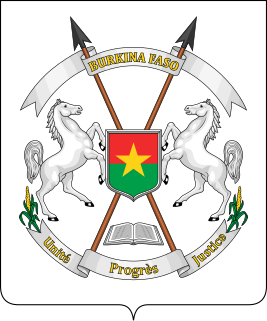 W
WThe coat of arms of Burkina Faso contains a shield based on the national flag. Above the shield the name of the country is shown, while below it is the national motto, Unité, Progrès, Justice. The supporters are two white stallions. The two plants emerging from the lower banner appear to represent pearl millet, an important cereal grain cultivated in this country where agriculture represents 32% of the gross domestic product. This coat of arms is similar to the old Upper Volta coat of arms, with the Burkina Faso flag replacing the Upper Volta flag in the middle. The coat of arms and its meaning is mandated by Law No 020/97/II/AN.
 W
WThe coat of arms of Burundi, adopted in 1966, consists of a shield surrounded by three spears. On the shield is the motto of the nation, as well as the head of a lion. Behind the shield there are three crossed traditional African spears. Under the shield the national motto of Burundi appears on a scroll: Unité, Travail, Progrès.
 W
WThe Great Seal of the State of California was adopted at the California state Constitutional Convention of 1849 and has undergone minor design changes since then, the last being the standardization of the seal in 1937. The seal shows the Roman goddess Minerva, known as Athena in Greek mythology, the goddess of wisdom and war, because she was born an adult, and California was never a territory; a California grizzly bear, the official state animal, feeding on grape vines, representing California's wine production; a sheaf of grain, representing agriculture; a miner, representing the California Gold Rush and the mining industry; and sailing ships, representing the state's economic power. The word Eureka, meaning "I have found it", is the California state motto.
 W
WThe coat of arms of Colombia contains a shield with numerous symbols. Perched on top of the shield is an Andean condor holding an olive crown and the condor symbolizing freedom. The national motto, Libertad y Orden, is on a scroll in between the bird and the shield in black font over golden background. The condor is depicted as displayed and looking to the right.
 W
WThe arms of the Democratic Republic of the Congo has changed several times since 1997. The current one was introduced in 2006 and depicts a leopard head, surrounded by an elephant tusk to the left and a spear to the right. Below are the three words which make up the national motto: Justice, Paix, Travail. It was adopted on 18 February 2006 by President Joseph Kabila.
 W
WThe coat of arms of the Cook Islands has a shield as its focal point. The shield is blue with fifteen white stars arranged in a circle, as found on the national flag, and is supported by a flying fish (maroro) and a white tern (kakaia). The helmet is an ariki head-dress of red feathers, symbolising the importance of the traditional rank system, and the name of the nation is on a scroll below the shield. The achievement is augmented by a cross and a Rarotongan club used by orators during traditional discourses, respectively symbolizing Christianity and the richness of Cook Islands' tradition, placed in saltire behind the shield.
 W
WThe national emblem of Djibouti was introduced after attaining independence from France on 27 June 1977. It was made by Hassan Robleh. It is bordered on the sides with laurel branches. Within this perimeter there is a vertical spear, in front of which is a shield. Underneath the shield, two hands rise away from the spear, both of which carry a large machete. These two hands symbolize the main two ethnic groups of the nation: the Afar and the Issa. The spear is topped by a red star. The star symbolizes the unity between the Issa and the Afar peoples. A Djibouti law established the seal and states its significance, and has been translated into English.
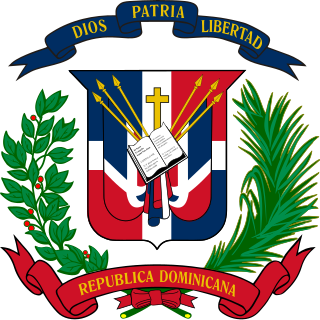 W
WThe coat of arms of the Dominican Republic features a shield in similarly quartered colors as the flag, supported by a bay laurel branch (left) and a palm frond (right); above the shield, a blue ribbon displays the national motto: Dios, Patria, Libertad. Below the shield, the words República Dominicana appear on a red ribbon. In the center of the shield, flanked by six spears, the front four holding the national flag, is a Bible with a small golden cross above it. The coat of arms appears in the center of the flag of the Dominican Republic.
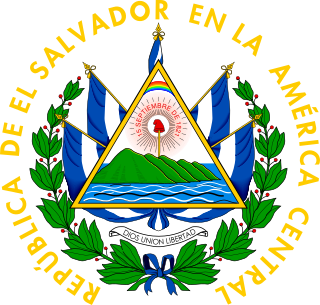 W
WThe coat of arms of El Salvador has been in use in its current form since 15 September 1912.
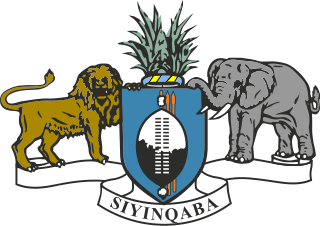 W
WThe coat of arms of Eswatini is a coat of arms depicting various symbols for traditional Eswatini culture. The lion represents the King and the elephant represents the Queen-mother. They support a traditional Nguni shield which represents "protection". Above the shield is the king's lidlabe, or crown of feathers, normally worn during Incwala. On a banner below the shield is Eswatini's national motto, Siyinqaba, meaning, "We are the fortress".
 W
WThe coat of arms of Fiji is the heraldic device consisting of a shield divided quarterly by Cross of St. George and charged with a gold lion at the top, supported by two Fijian warriors, one on each side, and topped with a canoe as the crest. Adopted in 1908 by a Royal Warrant, it has been the coat of arms of Fiji since that year, having been retained after independence in 1970. The escutcheon from the arms is featured on the flag of Fiji.
 W
WThe coat of arms of Georgia is one of the national symbols of the republic. It is partially based on the medieval arms of the Georgian royal house and features Saint George, the traditional patron saint of Georgia. In addition to St. George, the original proposal included additional heraldic elements found on the royal seal, such as the seamless robe of Jesus, but this was deemed excessively religious and was not incorporated into the final version.
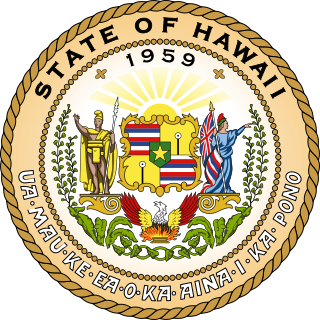 W
WThe Great Seal of the State of Hawaii was designated officially by Act 272 of the 1959 Territorial Legislature and is based on the territorial seal. Modifications to the territorial seal included the use of the words "State of Hawaii" at the top and "1959" within the circle. Provisions for a seal for the state of Hawaii were enacted by the Territorial Legislature and approved by Governor William F. Quinn on June 8, 1959. The passage of the Admission Act in 1959, admitted Hawaii as the 50th State of the United States of America on August 21, 1959.
 W
WThe flag and the coat of arms of Kelantan are state symbols of Kelantan, Malaysia. Like the flag of Kedah, the Kelantanese flag is red with a single charge from Kelantan's coat of arms, albeit partially.
 W
WThe coat of arms of Kenya features two lions, a symbol of protection, holding spears and a traditional East African shield. The shield and spears symbolize unity and defence of freedom. The shield contains the national colours, representing:Black for the people of Kenya. Red for the blood shed during the struggle for freedom. Green for the agriculture and natural resources. White for unity and peace.
 W
WThe Spanish autonomous community and province of La Rioja has a coat of arms, which was assigned to the former province of Logroño in 1957, and to the present autonomous community on its foundation in 1982. It consists of a shield which is divided vertically into two halves, featuring respectively the Cross of Saint James and a castle, and is surmounted by a royal crown. Also depicted are Monte Laturce and the Ebro river.
 W
WThe coats of arms of Lillehammer was approved by Royal resolution on April 4, 1898. It was created by the artist Andreas Bloch (1860–1917). The design depicts a Birkebeiner. This motif was chosen following a public competition. The official coat of arms also features a golden mural crown with three towers.
 W
WThe Great Seal of the State of Minnesota is the state seal of the U.S. state of Minnesota. Originally adopted in 1858, it has undergone several alterations since then, in 1971 and 1983.
 W
WThe coat of arms of New Zealand is the heraldic symbol representing the South Pacific island country of New Zealand. Its design reflects New Zealand's history as a bicultural nation, with a European female figure on one side and a Māori rangatira (chief) on the other. The symbols on the central shield represent New Zealand's trade, agriculture and industry, and a Crown represents New Zealand's status as a constitutional monarchy.
 W
WThe coat of arms of Niger shows a four-part flag draping in the national colors orange, white, and green. In the middle, the state seal is arranged. On a green or gold shield the four golden symbols are shown. In the middle, there is a sun, to the left there is a vertical spear with two crossed Tuareg swords, to the right are three pearl millet heads and underneath is the frontal view of a zebu head. Under the coat of arms, there is a ribbon bearing the name of the country in French: Republique du Niger. While the constitution of Niger stipulates the color of the symbols upon the shield, there is no uniformity on the color of the shield. The 1999 Constitution reproduces the text of earlier constitutions, making a distinction between the Seal of State for which no shield colour is stipulated and the Coat of Arms of the Republic for which Sinople is stipulated as the shield colour. Sinople is analogous to Vert (Green) in heraldry, but official buildings and documents do not display green shields. Embassies and official documents use white, with gold emblems. The website of the President of Niger uses gold or yellow with dark gold or black emblems. The National Assembly of Niger meets below a large coat of arms with the shield coloured gold and the emblems in a darker gold.
 W
WThe Seal of Niue, or the Public Seal of Niue, is the official seal of Niue. It was created in 1974 when Niue gained self-governing status and joined into free association with New Zealand.
 W
WThe Great Seal of the State of North Dakota is the official seal of the U.S. state of North Dakota. The coloring added to the seal varies by source.
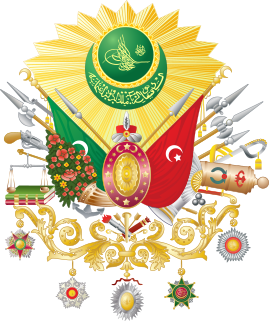 W
WEvery sultan of the Ottoman Empire had his own monogram, called the tughra, which served as a royal symbol. A coat of arms in the European heraldic sense was created in the late 19th century. Hampton Court requested from the Ottoman Empire a coat of arms to be included in their collection. As the coat of arms had not been previously used in the Ottoman Empire, it was designed after this request, and the final design was adopted by Sultan Abdul Hamid II on 17 April 1882.
 W
WThe national emblem of Papua New Guinea consists of a bird-of-paradise over a traditional spear and a kundu drum. Designed by Hal Holman, an Australian artist working for the Papuan government, Holman was also involved in the design of the National flag. Both the emblem and the flag was accepted by the House of Assembly of Papua and New Guinea and signed into law as the National Identity Ordinance by the Administrator Sir Leslie Johnson on 24 June 1971. The ordinance came into effect after its publication in the Papua New Guinea Gazette of 1 July 1971.
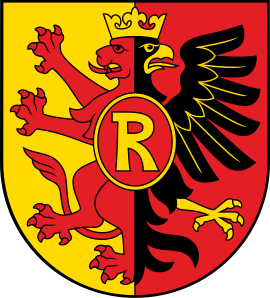 W
WThe Coat of arms of Radomsko County was laid out according to the following design: on a blue field one finds a red wall with a visible brick pattern, and two towers, between which is a shield partitioned in two, vertically. On the right red field is a silver half-lion, on the left silver field a black half-eagle, both of these share a golden crown. In each tower a rectangular opening is present. In the gate there stands a knight in silver armour, propped on his spear; he wears a silver helmet without any decorations.
 W
WThe heraldic ensigns of the Ministry of Internal Affairs consist of the following elements: large blue shield with a crusader golden eagle, having its head turned to the right, red peak and claws, open wings, holding a silver sword in its right claw; the green olive branch, symbolizing peace and order, replacing the mace from the coat of arms of the country; the small shield, placed on the eagle's chest, having five sectors which symbolize the most important structures of the ministry; at the bottom of the external shield, on a white scarf, the motto of the ministry is written in black: Latin: PRO PATRIA ET ORDINE IURIS, meaning "For the country and for the lawful order". The first sector represents the General Inspectorate of Romanian Police, the second sector includes the heraldic ensigns of the General Inspectorate for Emergency Situations, the third sector contains the ensigns of the General Inspectorate of Border Police, the fourth sector represents the General Inspectorate of Romanian Gendarmerie, the fifth sector represents the Administration, and the sixth sector contains the emblem of the National Archives.
 W
WThe coat of arms of Somalia was adopted on October 10, 1956 and was created by an unknown Somali man. The cheetahs which support the shield and the white star were also found on the coat of arms used in Italian Somaliland. Formerly, the arms of Somalia from June 8, 1919 featured a shield divided horizontally by a wavy white line. The top half of the shield was blue, with a cheetah in natural color surmounted by a white five-pointed star. Cheetahs are a common motif in Somali culture.
 W
WThe present coat of arms of South Africa was introduced on Freedom Day 27 April 2000 and designed by Mr Iaan Bekker. It replaced the earlier national arms, which had been in use since 1910. The motto is written in the Khoisan language of the ǀXam people and translates literally to "diverse people unite". The previous motto, in Latin, was Ex Unitate Vires, translated as "From unity, strength".
 W
WThe coat of arms of the Republic of South Sudan was adopted in July 2011 following independence from the Republic of Sudan. Prior to independence, South Sudan was an autonomous region of Sudan.
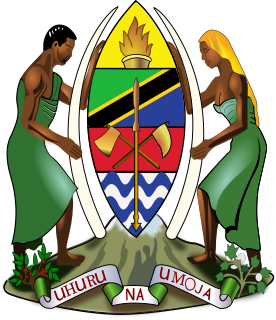 W
WThe coat of arms of Tanzania comprises a warrior's shield which bears a golden portion on the upper part followed underneath by the flag of Tanzania. It was designed by Mr Jeremiah Wisdom Kabati, at Bwiru, Mwanza in 1961.
 W
WThe Coat of arms of Tolima is the coat of arms of the Colombian Department of Tolima. The emblem was adopted by Law of December 7, 1815 ordained by the United Chambers of the Mariquita Province and sanctioned by José León Armero, the governor and general in command. In 1861 the coat of arms was adopted for the Sovereign State of Tolima by Decree of April 12 of the same year by General Tomas Cipriano de Mosquera and officially established on September 7.
 W
WThe coat of arms of Uganda was adopted three weeks before the proclamation of independence by the Uganda Legislative Council. On 1 October 1962 the arms were approved by Governor of Uganda Walter Coutts, and formally established by law on 9 October.
 W
WThe Department of the Army Seal and the Department of the Army Emblem are, respectively, the official seal and emblem of the United States Department of the Army. The "War Office Seal" was created in 1778 and the Emblem was developed out of the seal and approved in 1947.
 W
WThe Coat of arms of Vanuatu features a Melanesian warrior holding the spear standing before the mountain superimposed on the boar's tusk encircling two crossed namele fern fronds and the golden scroll on the bottom with the National Motto that reads: LONG GOD YUMI STANAP. The Bislama "long" is a preposition derived from the word "along" and has several flexible meanings, "in, on, at," and "with." When used referring to another with personhood, it is generally understood to mean "with ." The original version was designed by Australian artist Rick Frazer in 1980.
 W
WThe current coat of arms of Venezuela was primarily approved by the Congress on April 18, 1836, undergoing small modifications through history, reaching the present version.
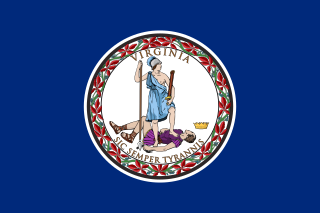 W
WThe Seal of the Commonwealth of Virginia is the official seal of the Commonwealth of Virginia, a U.S. state. The state flag of Virginia consists of the obverse of the seal against a blue background. A state flag was first adopted at the beginning of the American Civil War in April 1861, readopted in 1912, and standardized by the General Assembly in February 1950. The standing allegorical female figure of virtue is shown having vanquished tyranny, symbolized by a fallen king at her feet. She has an exposed breast in the manner of classical depictions of Amazons, making this the only state flag in the U.S. depicting a form of nudity. The motto, "Sic semper tyrannis," means "Thus always to tyrants." The flag may be decorated with a white fringe along the fly edge; this is usually done when the flag is displayed indoors.